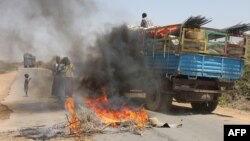NAIROBI —
African Union forces said they have reclaimed more territory from the al-Qaida-linked militant group al-Shabab in renewed military operations across Somalia. Restoring the government's political authority remains a pressing challenge.
The AU peacekeeping force in Somalia, known as AMISOM, said Thursday that Djiboutian soldiers have taken control of territory in Hiraan region, north of the capital, extending recent military gains.
"There are small towns toward which Djiboutians are now moving, but the objective is far beyond that," said AMISOM spokesman, Colonel Ali Hamud.
VOA's Somali Service reported that Djiboutian, Ethiopian and Somali troops recaptured Buloburbe, a town in Hiraan about 125 kilometers north of Mogadishu.
In the past week, Ethiopian soldiers under AMISOM retook control of several key towns in southwestern Somalia.
Somali officials said in some cases al-Shabab had fled from their positions before confronting the advancing soldiers.
The current operations represent the most significant progress regional forces have made against the militants since 2012, when the Kenyan military took control of the port city of Kismayo.
But military success does not come without challenges.
Mahamed Muse Tarey, executive director of the Somali Institute for Policy and Strategic Studies, notes that political disputes can arise quickly when territory is rapidly reclaimed.
"What we have realized before, is that some area was liberated from al-Shabab but there was not a political strategy in place. And what happened, there was a power vacuum, but also clan in-fighting." Tarey stated.
Kismayo serves as an example. After al-Shabab fled the city, a power struggle emerged between the Somali federal government, a Kenyan-backed regional leader and other local actors. At one point, five different men claimed to be the president of a newly formed state around Kismayo.
The next challenge could be Gedo region, which borders both Ethiopia and Kenya in southwestern Somalia, and where AMISOM has seized territory from al-Shabab.
Tarey, who comes from Gedo, sees the possibility of a struggle for influence between Somalia's neighbors. "Because Kenya wants certain people to come forward, Ethiopia might come up with the people, there will be a circle of conflicts and conflicts and conflicts if they do not come up with a common strategy where the government has a role," he stated.
In a message earlier this week, al-Shabab's leader, Ahmed Abdi Godane, called on Somalis to take up arms against Ethiopian forces inside Somalia.
Despite losing territory to AMISOM in recent years, the militant group has continued to launch suicide attacks against government and international targets, including an assault on the presidential palace in Mogadishu last month that killed at least 17 people.
The AU peacekeeping force in Somalia, known as AMISOM, said Thursday that Djiboutian soldiers have taken control of territory in Hiraan region, north of the capital, extending recent military gains.
"There are small towns toward which Djiboutians are now moving, but the objective is far beyond that," said AMISOM spokesman, Colonel Ali Hamud.
VOA's Somali Service reported that Djiboutian, Ethiopian and Somali troops recaptured Buloburbe, a town in Hiraan about 125 kilometers north of Mogadishu.
In the past week, Ethiopian soldiers under AMISOM retook control of several key towns in southwestern Somalia.
Somali officials said in some cases al-Shabab had fled from their positions before confronting the advancing soldiers.
The current operations represent the most significant progress regional forces have made against the militants since 2012, when the Kenyan military took control of the port city of Kismayo.
But military success does not come without challenges.
Mahamed Muse Tarey, executive director of the Somali Institute for Policy and Strategic Studies, notes that political disputes can arise quickly when territory is rapidly reclaimed.
"What we have realized before, is that some area was liberated from al-Shabab but there was not a political strategy in place. And what happened, there was a power vacuum, but also clan in-fighting." Tarey stated.
Kismayo serves as an example. After al-Shabab fled the city, a power struggle emerged between the Somali federal government, a Kenyan-backed regional leader and other local actors. At one point, five different men claimed to be the president of a newly formed state around Kismayo.
The next challenge could be Gedo region, which borders both Ethiopia and Kenya in southwestern Somalia, and where AMISOM has seized territory from al-Shabab.
Tarey, who comes from Gedo, sees the possibility of a struggle for influence between Somalia's neighbors. "Because Kenya wants certain people to come forward, Ethiopia might come up with the people, there will be a circle of conflicts and conflicts and conflicts if they do not come up with a common strategy where the government has a role," he stated.
In a message earlier this week, al-Shabab's leader, Ahmed Abdi Godane, called on Somalis to take up arms against Ethiopian forces inside Somalia.
Despite losing territory to AMISOM in recent years, the militant group has continued to launch suicide attacks against government and international targets, including an assault on the presidential palace in Mogadishu last month that killed at least 17 people.









